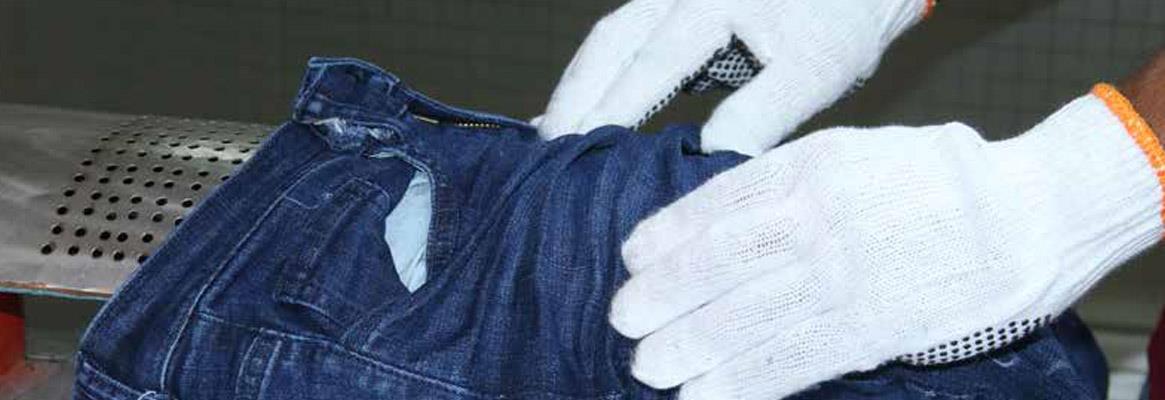Denim manufacturing units across India are beset with problems: low-key weddings, cancelled holidays, labour shortage, pending payments, dwindling orders, spiralling shipping costs. It’s a night without an end.
Denims have been the popular choice of casualwear in India for a while now. But few in this country are aware that what is referred to as denim is an advanced version of the dungaree cloth that has been produced in India for hundreds of years (see Box: A Story Less Known: From Dungaree to Denim).
Dungarees have faded away, and things don’t look too bright at the moment for denim.
Ahmedabad: The hub of denim production
There are about 7,000 denim garment manufacturers in Gujarat, with 70 per cent of them located in Ahmedabad. The rest are split among Surat, Rajkot, and Bhavnagar. The main reason for the success of denim apparel manufacturers in Ahmedabad is the quality of the denim washing segment here, according to Arpan Shah, chairman (arbitration) and treasurer of the Gujarat Garment Manufacturers Association (GGMA).
Denim garments need to be washed after manufacture to give them an aesthetic finish, enhance its appeal, and render strength to the fabric. Unavailability of quality washing facilities in proximity can increase both the cost and production time of the final product. Another reason is the huge scale itself of the production of denim textiles in Ahmedabad. In fact, Ahmedabad is the biggest manufacturer of denim textiles not only in India, but across Asia as well. According to Shah, “Denim is synonymous with the fashion industry. It is widely worn in festivals and at weddings. The bridegroom and their family members wear formals while the rest wear casuals (as in, denims). But then, festivals were mostly not been celebrated since the countrywide lockdown in March2020. Weddings too have been reduced to low-key affairs. Sales of denim garments, therefore, have been badly hit.
“Deepak Meghana, who is into jeans manufacturing, says denims had always been a hot-selling category, but not since the pandemic. For denims, April and May are the biggest season, even bigger than Diwali. That is because India’s biggest wedding season during this period also coincides with Eid and the ensuing summer holidays. Except for the wedding reception, denim is the casualwear of choice. The mid-range casual wear shoots up as the holidays commence. With the April-May season having flunked both last year and this, denim sales have nosedived.
Moreover, during the lockdown workers were “stuck here and the production was also not happening. We spent a large amount in providing food and daily needs to them. Now, labour charges have increased by 50 per cent compared to pre-COVID times, according to Monil Dadlani, another denim garment manufacturer. Previously, the unit activity for which the labour charges were 80 paise has now gone up to ₹1.20. Apart from this, there were transportation issues when other states faced lockdowns. “The inter-state business has suffered terribly. Overall, denim sales have reduced to 50 per cent over the last one year.”
Denim manufacturers are in a soup for another reason, according to Himanshu Patel, who is into job work. The prices of raw material have increased by 15-25 per cent for different types of denim textiles. There is a severe recession too in the market. While manufacturers are already having difficulties in procuring orders from traders and wholesalers, getting orders quoting the new increased prices is getting more difficult. Patel too talks about weddings. Government restrictions mean that an event can be attended by a maximum of 50 people. Such a small number means that most of the attendees would be close family members who would rather go in for formals or indutavs or ethnic wear. He feels that buying clothes is not a priority for people compared to essentials. The financial crunch brought about by the pandemic has also meant that people do not have enough disposable cash for apparel.
North India: Manufacturers severely affected
Punjab-based Surendar Singh has a manufacturing unit that makes readymade denim garments. According to Singh, there has been minimal business at retail counters for more than a year now, with the purchasing power of middle-class consumers plummeting considerably. So, retailers are not buying new stock, and pending payments are not being cleared either.
Manufacturers are ready to produce, but without orders they cannot keep manufacturing. Many have also stopped selling in credit as earlier credits have still not been cleared. It is a tricky situation. “Over the last one year, our business has been down by 90 per cent. Workers too are in dire straits since factories are running at low production capacity, forcing owners to work with few workers. Unemployment among workers is increasing by the day.”
For Ludhiana-based denim manufacturer Anmol Sharma, production has been running at a reduced capacity of 50 per cent for the past year. In this region, workers in denim factories are mostly from Bihar and Uttar Pradesh. Many workers returned, while others are sceptical about how the future is going to play out. However, Sharma is hopeful things may improve gradually.
According to Ankit Tripathi, who represents a leading denim manufacturer, the problems of high yarn cost and reduced market demand is affecting all manufacturers. Besides, manufacturers and exporters are facing another problem—that of increased costs of freight to foreign countries. For example, a shipment to South American countries used to cost around $1,500-2,000. Now charges for the same shipment have surged to $8,000.
Road to recovery
Meghani is hopeful that the way cases are reducing, better days may be just round the corner. He believes that markets should turn to normal within two months. For the moment, the best strategy for denim manufacturers, traders and retailers seems to be to wait and let the difficult times pass by. He also has a suggestion. At present, there is a 5 per cent GST for readymade garments below the tag of ₹1,000 and 12 per cent for garments of higher value. In these difficult times, the government should reduce the GST to 5 per cent for all garments. “We have been making representations at the association level to consider a reduction in GST, but there has not been any response so far from the government’s side.” Small manufacturers like him always have a pending’s refund of ₹10-12 lakh from the government. If the government clears this amount in time, it could be of immense help to people like Meghani.
Dadlani says the textiles minister has given a statement saying that textile industries donot need any economic package. But the government should understand that the textiles industry is one of the biggest employers in the country. They employ a very large number of unskilled people who do not have any other option to earn a living. It would be good for everyone if the government can come up with a package that could help industry, he feels.
This article was first published in the July 2021 edition of the print magazine.








Comments